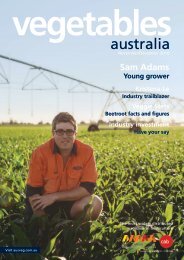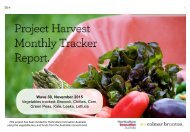potatoes
PA-DECJAN2016
PA-DECJAN2016
Create successful ePaper yourself
Turn your PDF publications into a flip-book with our unique Google optimized e-Paper software.
30<br />
The psychology<br />
behind spud sales:<br />
A wrap-up of the<br />
Potato Tracker<br />
project<br />
THE POTATO TRACKER CONSUMER RESEARCH<br />
PROJECT WAS RUN BY COLMAR BRUNTON<br />
ACROSS A 12-MONTH PERIOD, WITH A<br />
NEW WAVE OF RESEARCH RELEASED EVERY<br />
MONTH. POTATOES AUSTRALIA LOOKS<br />
BACK ON THE HIGHLIGHTS OF EACH WAVE,<br />
GIVING GROWERS THE PERFECT CHANCE TO<br />
IDENTIFY MARKET OPPORTUNITIES FOR THEIR<br />
BUSINESSES.<br />
Wave 1: September 2014<br />
The initial Potato Tracker<br />
report provided a range of<br />
useful insights about consumer<br />
perceptions of <strong>potatoes</strong>. The<br />
findings showed that 66 per<br />
cent of consumers purchased<br />
<strong>potatoes</strong> because they were<br />
easy to prepare and cook with.<br />
Awareness of potato varieties<br />
was high, with Desiree, Dutch<br />
Delight, Pink Eye and Pontiac<br />
being the varieties of which<br />
consumers were most aware.<br />
While consumers intended<br />
to keep purchasing <strong>potatoes</strong><br />
in future, the main barrier to<br />
buying more was that they<br />
‘consume enough for their<br />
needs’. One of the most<br />
encouraging findings was that<br />
<strong>potatoes</strong> were considered<br />
to represent good value for<br />
money, particularly washed and<br />
brushed <strong>potatoes</strong>.<br />
Wave 2: October 2014<br />
Findings from the October<br />
report showed that the future<br />
for <strong>potatoes</strong> was strong, with<br />
younger age groups having a<br />
particularly high propensity<br />
to purchase more <strong>potatoes</strong>.<br />
Given the large proportion<br />
of respondents purchasing<br />
both washed and brushed<br />
<strong>potatoes</strong>, the report identified<br />
the opportunity to differentiate<br />
between the two and promote<br />
the benefits of each.<br />
Diet concerns and weight<br />
management were a key<br />
barrier to purchase, opening<br />
up the possibility of educating<br />
consumers on the health<br />
benefits of <strong>potatoes</strong>. It was also<br />
reported that consumers want<br />
information on the suitability of<br />
different varieties for different<br />
cooking styles, as well as<br />
country of origin and best before<br />
dates. The report recommended<br />
that growers work with<br />
manufacturers, packers and<br />
retailers to communicate this<br />
information to consumers.<br />
Wave 3: November 2014<br />
During November, findings<br />
indicated that 55 per cent of<br />
consumers believed that they<br />
already consumed enough<br />
<strong>potatoes</strong> for their needs.<br />
They also lacked confidence<br />
in cooking with multiple<br />
varieties of potato. The report<br />
suggested that these barriers to<br />
purchase could be reduced by<br />
providing recipe ideas and cooking<br />
instructions, as well as new<br />
occasions for eating <strong>potatoes</strong>.<br />
Another interesting finding was<br />
that purchase and consumption<br />
was more popular in older age<br />
groups and ‘empty nesters’.<br />
However, there was also an<br />
opportunity to increase appeal<br />
to younger, busier consumers by<br />
offering more pre-prepared formats<br />
and mixed vegetable bundle<br />
packs.<br />
Wave 4: December 2014<br />
This wave of research found<br />
that 63 per cent of consumers<br />
purchased <strong>potatoes</strong> because they<br />
enjoyed the taste. Potatoes were<br />
consistently served with carrots,<br />
peas and broccoli, providing an<br />
opportunity to explore packaging<br />
options and bundle these<br />
vegetables together, perhaps precut.<br />
Perceptions that some foods<br />
were more suitable for families<br />
were shown to be on the rise.<br />
Given this, <strong>potatoes</strong> could be<br />
marketed to families by clearly<br />
labelling the number of serving<br />
sizes on packaged <strong>potatoes</strong>.<br />
Meanwhile, the report found that<br />
gluten free and other health trends<br />
were continually on the rise and<br />
recommended an investigation<br />
into new processing opportunities<br />
for <strong>potatoes</strong>, as there may be








